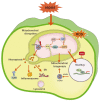The Pathogenesis of Sepsis and Potential Therapeutic Targets
- PMID: 31671729
- PMCID: PMC6862039
- DOI: 10.3390/ijms20215376
The Pathogenesis of Sepsis and Potential Therapeutic Targets
Abstract
Sepsis is defined as "a life-threatening organ dysfunction caused by a host's dysfunctional response to infection". Although the treatment of sepsis has developed rapidly in the past few years, sepsis incidence and mortality in clinical treatment is still climbing. Moreover, because of the diverse manifestations of sepsis, clinicians continue to face severe challenges in the diagnosis, treatment, and management of patients with sepsis. Here, we review the recent development in our understanding regarding the cellular pathogenesis and the target of clinical diagnosis of sepsis, with the goal of enhancing the current understanding of sepsis. The present state of research on targeted therapeutic drugs is also elaborated upon to provide information for the treatment of sepsis.
Keywords: biomarkers; pathogenesis; sepsis; therapeutic drugs.
Conflict of interest statement
The authors have declared no conflict of interest.
Figures




References
-
- Rocheteau P., Chatre L., Briand D., Mebarki M., Jouvion G., Bardon J., Crochemore C., Serrani P., Lecci P.P., Latil M., et al. Sepsis induces long-term metabolic and mitochondrial muscle stem cell dysfunction amenable by mesenchymal stem cell therapy. Nat. Commun. 2015;6:10145. doi: 10.1038/ncomms10145. - DOI - PMC - PubMed
Publication types
MeSH terms
Substances
Grants and funding
- 81803547/National Natural Science Foundation of China
- 2018J01720/Natural Science Foundation of Fujian Province
- IRTL1703, FZSKG2018013/Innovative Research Teams Program II of Fujian Normal University in China
- FZHJ14/the Public Service Platform for Industrialization Development Technology of Marine Biological Medicine and Product of State Oceanic Administration
LinkOut - more resources
Full Text Sources
Other Literature Sources
Medical
Miscellaneous

